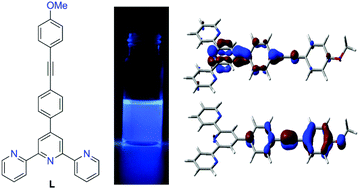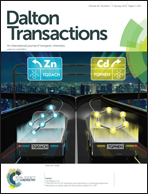Synthesis, structure and photophysical properties of a highly luminescent terpyridine-diphenylacetylene hybrid fluorophore and its metal complexes†
Abstract
A new fluorescent terpyridyl-diphenylacetylene hybrid fluorophore 4′-[4-{(4-methoxyphenyl)ethynyl}phenyl]-2,2′:6′,2′′-terpyridine, L, was synthesized via Sonogashira cross-coupling of 4′-(4-bromophenyl)-2,2′:6′,2′′-terpyridine and 4-ethynylanisole in the presence of Pd(PPh3)4/CuI as a catalyst. The solid state structure of L shows a trans arrangement of pyridine nitrogen atoms along the interannular bond in the terpyridine domain. Five transition metal complexes of L, {[FeL2](CF3SO3)2 (1), [ZnL2](ClO4)2 (2), [CdL2](ClO4)2 (3), [RuL2](PF6)2 (4), and PtMe3IL (5)}, have also been synthesized and characterized by spectroscopic methods and single crystal X-ray analysis. The X-ray crystal structures of complexes 1–3 show a distorted octahedral MN6 arrangement with tridentate coordination of the two terpyridine ligands, whereas in complex 5 the ligand L binds in a bidentate fashion. The ligand L displays bright blue emission in the solid state and in both non-polar and polar organic media. The fluorescence quantum yield of L is exceptionally high for a monoterpyridine ligand of its kind, which can be rationalized with density functional theory calculations. The electronic structure of L shows that the fluorescence involves intramolecular charge transfer from the diphenylacetylene moiety to the terpyridine group, and it is not affected by the usual non-radiative relaxation processes such as pyridine rotation. The Fe(II), Ru(II) and Pt(IV) complexes of L were found to be non-emissive, whereas both Zn(II) and Cd(II) complexes displayed significant green emission attributed to intra-ligand charge transfer states. These results were supported by the observed red-shift of the emission maxima of complexes 2 and 3 with increasing the solvent polarity.


 Please wait while we load your content...
Please wait while we load your content...